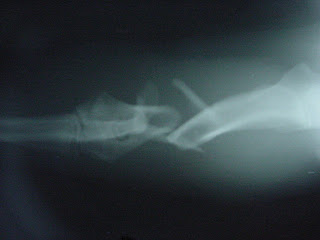Sunday, December 28, 2008
Chocolate Toxicity
We always see chocolate toxicity this time of year, because a lot of chocolate gifts are placed under the Christmas tree where dogs sniff it out. You should always call the emergency vet on call to ask them what to do if your dog eats chocolate. We can calculate the toxic amount if we have the amount and type they ate and the weight of your dog. There are a lot of variables with chocolate ingestion in dogs. The level of toxicity depends upon how much they eat, how much the dog weighs and what type of chocolate they ate. Dark chocolate is the most toxic. The toxic ingredient in chocolate is Theobromine. Quantity is important...the more they eat the worse the symptoms can be. Symptoms include: vomiting and hyperactivity, difficulty walking...then elevated heart rate, seizures and possibly death. There is no specific antidote but if your dog recently ate the chocolate within the last 2 hours and if it is determined that a toxic level was ingested, inducing vomiting will be the first course of action. We must then monitor them for the progressive symptoms. If signs develop then medication and treatment will become more aggressive. The best way to prevent ingestion is to keep the chocolate out of reach, play it safe and hide the gift somewhere in a drawer or high on a shelf and put a note under the tree as a reminder instead.
Puppy Femur Fracture


This was a Transverse Fracture of the Proximal Femur in a 5 month old puppy. We performed surgery last week with a bone plate and five screws. Puppy bone is soft and sometimes difficult to repair with hardware because it can be difficult to get implants to hold tightly. We also had to avoid placing screws into the growth plates and the joint space to prevent problems with recovery and growth. Fortunately, with proper confinement and rest, puppy bone is still growing with osteoblast cells and should heal more quickly than older mature bone. The estimated healing time is 6 to 8 weeks and typically do not remove this type of implant unless we encounter problems.
Saturday, December 13, 2008

Fortunately, we now have the use of a MyLab 50 ultrasound that gives us the capabilities of screening and helping diagnose disease in pets. This is an image we took of a polycystic kidney in a cat. Our ultrasound also has color flow capabilities and we also have the ability to send these images and films via telemedicine to a board certified radiologist for evaluation.

A 6 month old "Lab Puppy" was hit by a vehicle 3 months ago. She suffered a comminuted (multiple breaks) humerus fracture in the front leg. She had a lot of soft tissue swelling and bruising in the surrounding muscle layers.

Three months after an external fixation device was placed with a central I.M. pin, and bone graft from her hip bone...her leg has healed and we removed the implants.
Her healing over three months was quick because the owners did a great job in home care and reporting any problems she had right away. Way to go!!
Remembering "Reno"

"Reno" was a most unique dog who was part of our staff member's family for 14 years. He lost his long battle with Cutaneous Hemangiosarcoma this year. We performed multiple laser treatments as new skin cancer lesions appeared but eventually the cancer spread to other areas of his body. His breed (Italian Greyhound) is predisposed to this type of skin cancer. It is also can be associated with sun exposure to their skin. Although most of his life he only had 3 legs his personality was larger than life. He has a special place in our hearts and we will never forget him. We love you "Reno"!
Subscribe to:
Comments (Atom)
